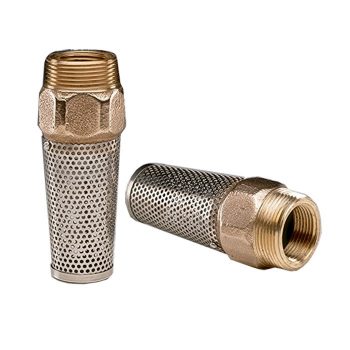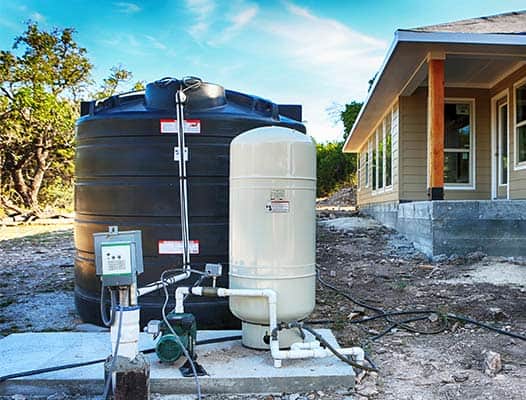Now you have a pump installed in your well at home but aren’t sure what valve to use. Although, you might be confused about which one to use. But we’ve helped simplify it by differentiating between the check valve and foot valve and their primary functions.
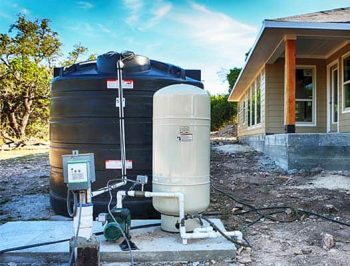
Image Source: Google
Let’s first consider the differences between valves and their applications in the excellent pump. A proper understanding of the primary uses of the check valve and foot valve will further answer the question of which valve option is better for the excellent pump. However, the foot valve is most applicable because it has an open end with a shield to trap debris.
Check valve
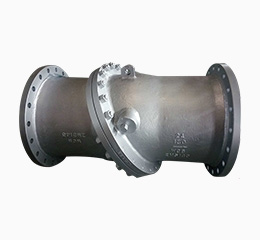
Image Source: xhval.com
Can I use a check valve instead of a foot valve for the well?
A check allows the flow of gas or fluid only in one direction. The valve’s external shells (bodies) are made of plastic or metal, and it operates automatically without any external control. They are small, simple, less expensive, and part of household items.
Check valves are mounted anywhere in the suitable pumps primarily to prevent the backflow of fluid, but a foot valve is placed at the bottom of the excellent pump. Furthermore, a check valve has two-port valves, but a foot valve has one opened end, and it’s ideal for use in suitable pumps because it keeps the pump primed and prevents water backflow.
Check Valve Uses
Let’s further consider the popular uses/application of a check valve;
To prevent damage to well pumps and other equipment such as centrifugal pumps caused by water backflow. Also, check valves help prevent mixing different media or contamination involving two reservoirs. For instance, in the case of water treatment plants, the check valve prevents the treated water from mixing with the contaminated one. They equally serve as vacuum breakers to allow air into the piping system to avoid interrupting the liquid flow.
Foot valve
Foot valve is which type of valve.
A foot valve is a non-return valve, a one-way valve, or a retention valve that permits fluid flow only in one direction. As the name implies, a ”foot valve,” it’s installed at the end of a pump or pipeline.
What is Foot Valve
A foot valve is a water pump valve having only one thread at the end of it. When the pump is in operation, pressure builds up that sucks up through the pipe. Placing a foot valve in the good pump extracts water from the underground well in one direction.
When the pump stops working, the pressure reduces. This way, the foot valve prevents any water remaining in the pipe from flowing back into the well. This principle makes the foot valve ideal for ponds, pools, and wells.
What is Foot Valve made From (With Foot Valve Diagram)?
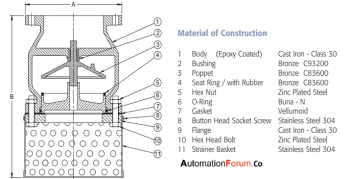
Image Source: Google
Foot Valve Uses
The foot valve is valuable and applicable in several instances, which include;
- It is suitable in all kinds of pneumatic systems to prevent the pump column from draining when the pump is shut down.
- To maintain hydraulic pressure.
- Used in ponds, pools, and other scenarios where the pump is needed, such as lake pumps, deep well pumps, water/well pumps, etc.
- Useful in sump pumps which are applicable in industrial settings.
- Designed to keep the pump primed for a unidirectional flow of liquid.
How Does Foot Valve Works
As earlier stated, a foot valve allows for a unidirectional flow of liquids in a pipe without any reversal, which means it can be used to extract water from the well without a backflow. Let’s consider in-depth the foot valve working animation in pumping and water well.
- Firstly, the valve is mounted at the pick-up end of the piping, that is, the end that allows for water extraction.
- When operating the pump, it sucks water through the pipe. While at the same time, the valve opens, and water flows upward because of the pressure coming from the water.
- When the pump stops working, the upward pressure reduces or stops. The law of gravity takes effect, causing the remaining water to run down the pipe and back into the well. However, the foot valve comes into play, preventing the backflow of the water.
- The water in the pipe exerted much pressure on the foot valve. But because the valve is one-way directional, it doesn’t open at the other end. Instead, the pressure tightens the valve and prevents any reversal of water from the pump back into the well.
Why foot valve is used
A high-quality foot valve conserves energy and prevents well pumps from damaging, prolonging their lifespan. But a foot valve is recommended for any system requiring a one-way liquid flow. There are several situations where a foot valve is needed.
It’sIt’s best to use a high-standard foot valve, as it can be challenging to uninstall once mounted. In addition, a PVC foot valve is cost-effective and lightweight, but when high temperature or pressure is involved, metal valve option like stainless steel and bronze is preferred.
Foot valve for well pump: why you cannot just use a check valve
It’s crucial to note the difference between a check valve and a foot valve and why you can’t just use a check valve.
- With the multiple threads present on a check valve, it can be placed at the discharge side of the well pump line to discharge water, but a foot valve can only be placed at the bottom/end of the well pump for water intake to prevent backflow. This way, it prevents the pump from burning out and keeps it primed.
- Also, foot valves are useful on deep well applications to prevent loss of prime in the well piping system, but a check valve is mostly on the discharge side of the pump to prevent water from flowing backward.
Why foot valve is good for well pump
You might be questioning why foot valves are necessary for well pumping. Check out the reasons below;
- Foot valves come with a surge block, which exerts pressure on the valve body to remove residues and allow for easy water flow.
- A foot valve has a strainer attached to its inlet port to prevent dirt in the well from entering the valve and sticking to it.
- A foot valve has NPT connections with a filter attached to it, preventing the valve from clogging, preventing the well pump from being damaged.
How to Replace Foot Valve for Well
A faulty foot valve in your well causes the pump to lose its prime between cycles. Check out this guide below to help replace your foot valve;
- Disconnect the pump from the power source.
- Using an adjustable wrench, loosen the bolts at the top of your good seal.
- With the aid of a pipe wrench, detach the union fitting at the wellhead.
- Remove the pipe from the well and place it on a flat surface.
- Unscrew the valve and remove it from the bottom of the well.
- Clean the thread on the valve and apply a coat of thread sealant.
- Using the pipe wrench, tightly screw the foot valve onto the well.
Foot valve: best choice for a good pumping
As we wrap up, we will argue that the foot valve is the best choice for well pumping because of its many advantages. The internal balls allow quick sealing and valve reaction and flexibility to fit into all types of suitable pumps. This and many more benefits mentioned in this article make the foot valve a better option than other valves.
Foot valves are usually made from heavy-duty cast iron, stainless steel, plastics, PVC, and bronze. Since they’re used for water service purposes, these materials have a long-lasting effect even when immersed in water.
